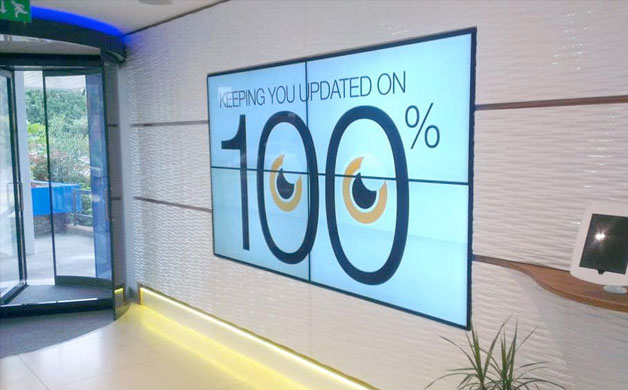Digital signage can be found just about anywhere the general public are. Extensively used in the retail industry and increasingly utilised in a host of other businesses and organisations, digital signage enables effective audience communication (and participation if you go interactive) in a visually engaging way.
Comprising of electronic signage that uses technologies such as LCD, LED screens or projection to display digital images, video, web pages, branded media, menus, maps, weather, text – (the list is extensive). It also provides a method of advertising, wayfinding, information sharing, marketing and the communication of brand messages.
In short – digital signage is a method of displaying any content, on a range of different screens, in a huge array of locations. Why not read our previous blog for some inspiration!
When it comes to planning your digital signage solution, there is a lot to think about. The more you can cover in advance, the fewer surprises and unexpected costs and delays down the road. These steps will help get you started.
Get the Right People Involved
- Identify one technical leader – this will be someone in your IT department.
- Identify one content leader – this will likely be someone in Marketing or Communications with an eye for design and an understanding of what type of information you want to publish for your audience.
Agree on your Goals
- Nail down what you want to achieve with all stakeholders.
- Talk to your HR and communications managers, department directors and executives to get their input.
- Write this down in as much detail as possible because it’ll help you measure your return on investment later.
Imagine how you’ll use the System
- Draw out workflows for how the system will operate within your organisation.
- What departments will contribute content and manage the system?
- Where will the hardware live and who maintains it?
Plan your Content
- The type of content you want to show will determine where you show it.
- List the types and sources for communications you’ll want to publish.
- Consider any data integration or applications you’ll want to tie into the system.
- Think about using communications you already have as a starting point.
Consider Creative
- Do you have in-house designers? If not, you may need to budget for creative help.
- Consider touchscreens for wayfinding, donor boards and other interactive content.
- Think about brand standards, and how you’ll set up screen layouts and templates.
Plan your Policies
- Determine who can contribute content, the hierarchy and approval process.
- List basic branding criteria, formatting rules and policies.
- If you’re using the system for emergency alerts, create a separate policy.
Map out your Screens
- High traffic areas are best for digital signage displays. (Don’t let wiring dictate placement.)
- You can mount small displays in cubicles, library stations, or even cafeteria booths.
- Will you want to show messages on websites, desktop screensavers or mobile phones?
- Consider digital room signs for conference room management.
- Will any screens use audio for videos or streams?
- Don’t forget about ASA compliance.
Check the Specs
- Evaluate and choose vendors for your digital signage system.
- Involve an experienced digital signage AV/IT integrator and ask them to review your plans.
- Review technical specs and requirements to make sure the system meets your needs.
Write a Project Plan
Your plan should describe the key action items, time frames and resources:
- The location of displays and which screens will show what
- A budget for installation and ongoing expenses
- Potential revenue sources like advertising
- IT issues like connectivity, network and security policies
- Support options for maintenance and upgrades
Consider a Pilot
- Test equipment, processes and content on a small-scale before launching across your entire organisation.
- Lower risks across the board by evaluating goals and resources in a controlled environment.
- Increase stakeholder buy-in through participation in the pilot, adjustment and final roll out of the system.
Essentially the objectives and goals for the implementation of a digital signage solution need to be clearly understood, in order that the best product fit can be made, and the proper software support provided.
The advantages of a professional digital signage solution are vast; getting the key components right is crucial to its successful implementation. That relies on finding the right digital signage partner to work with. Please call the team at Quad Vision, we can help: 03300 419019.
Credit: Wallboard Display

